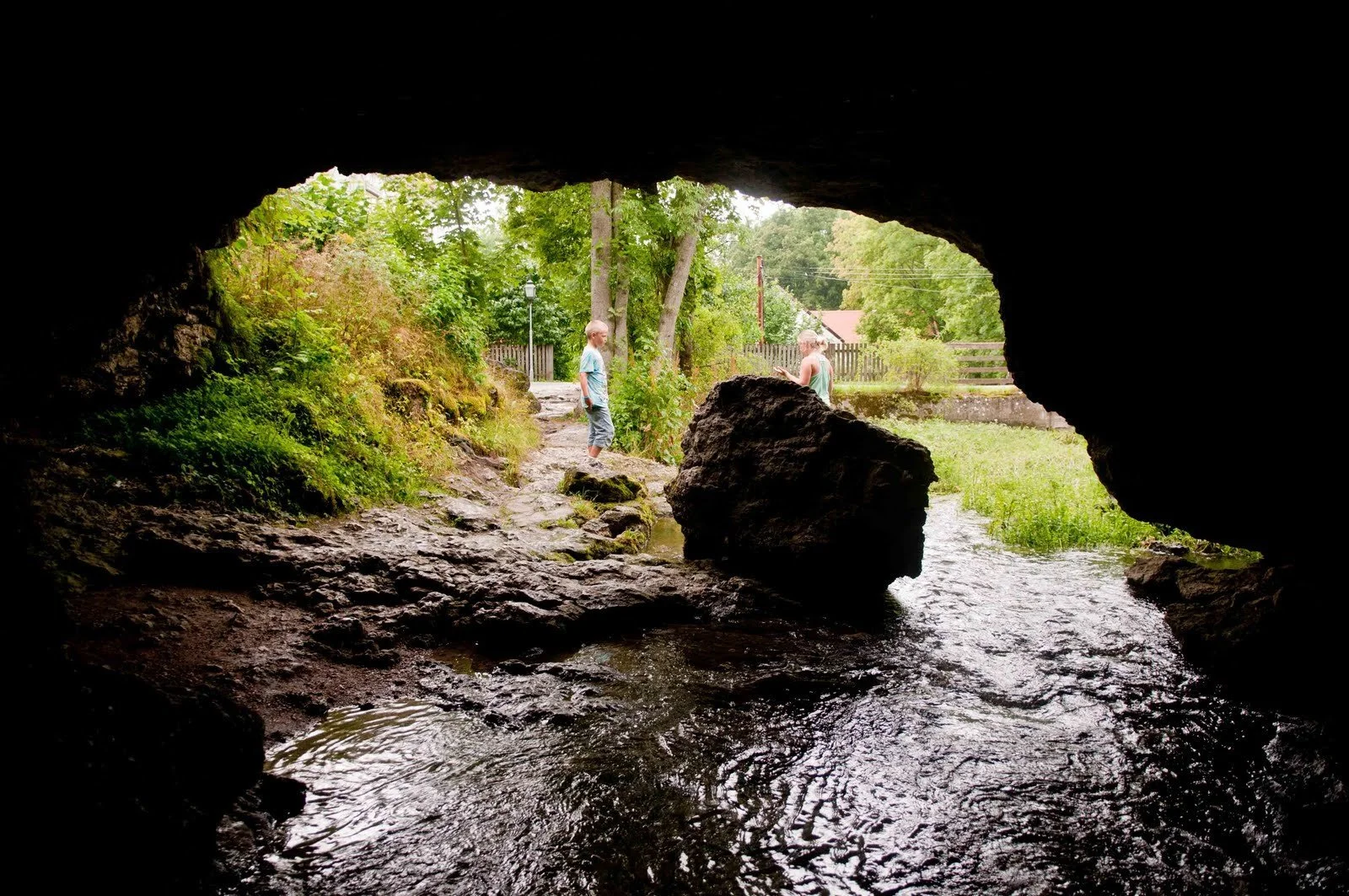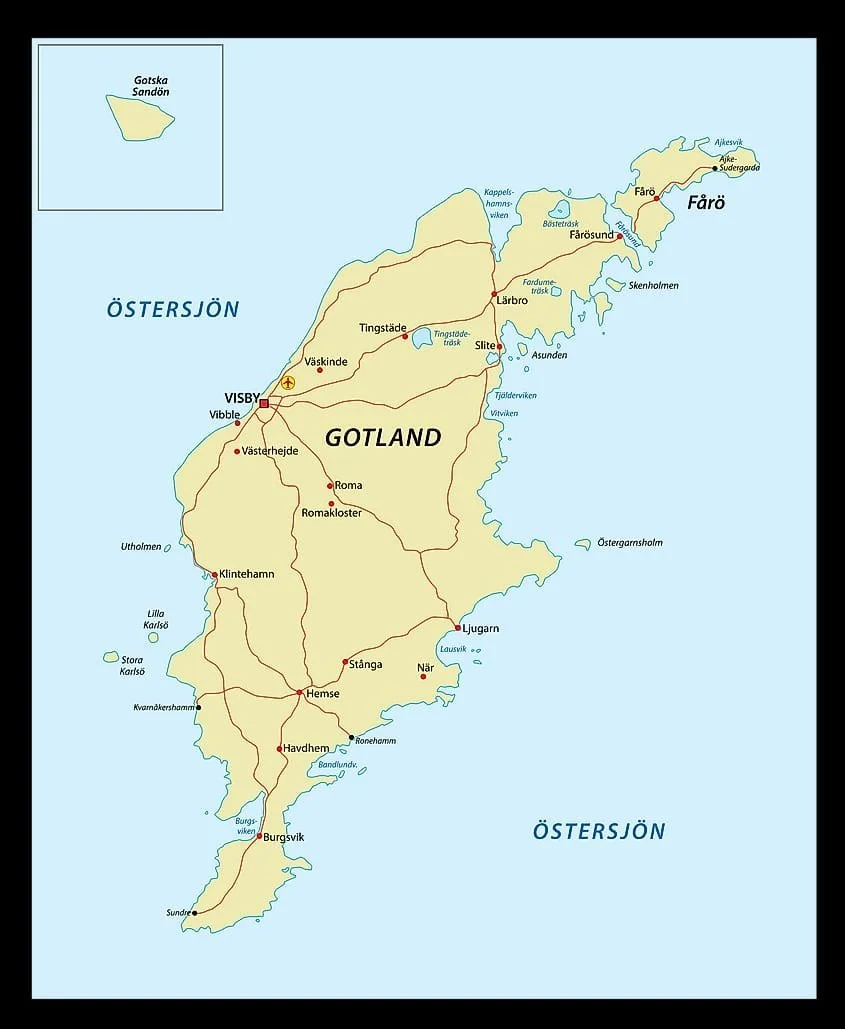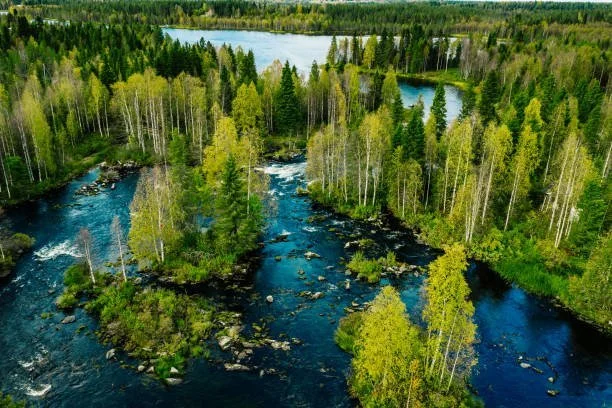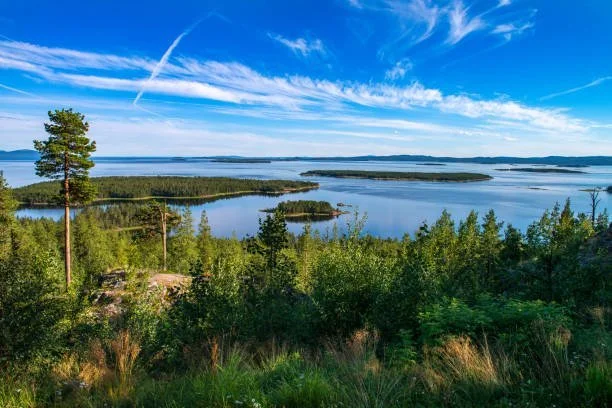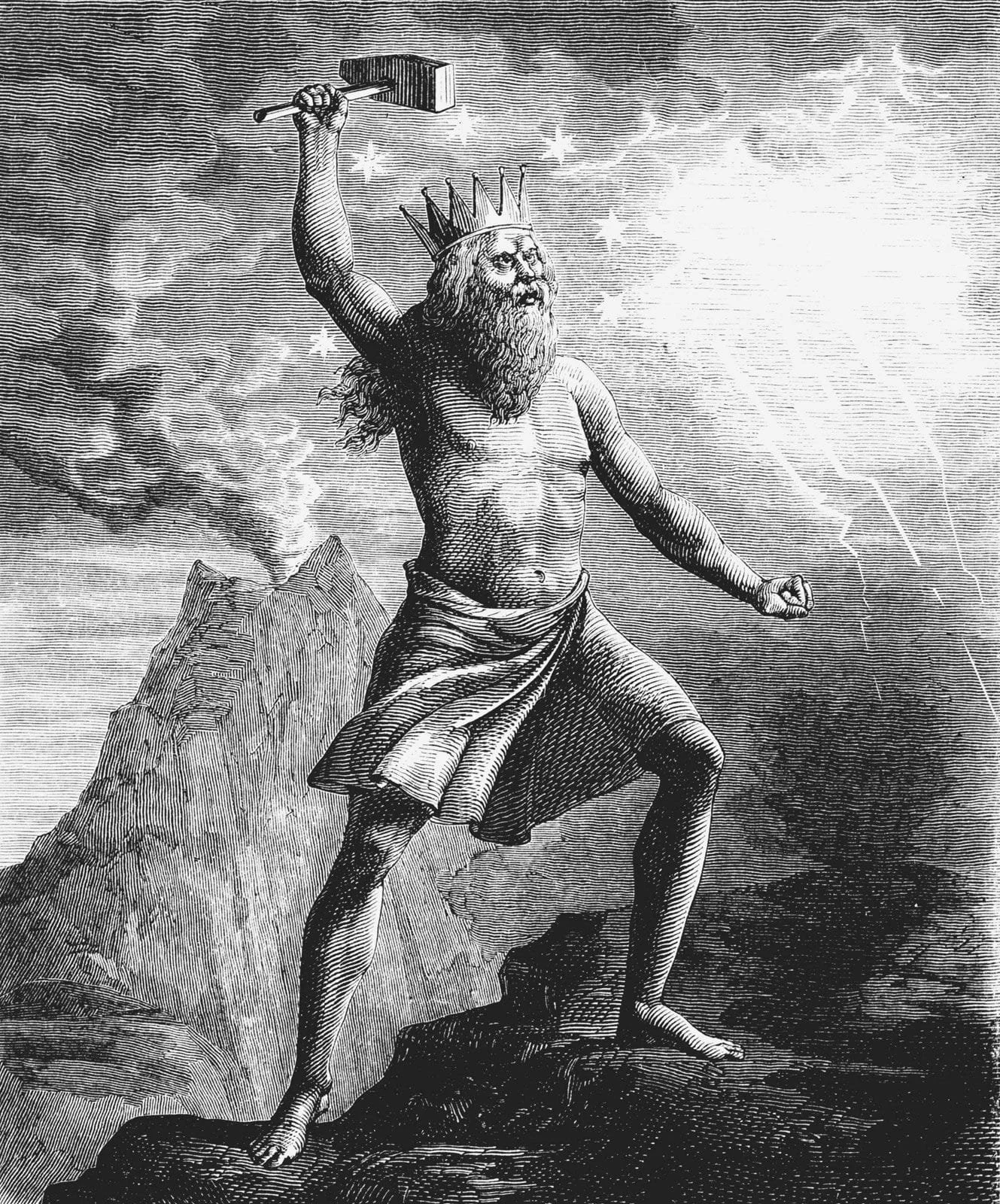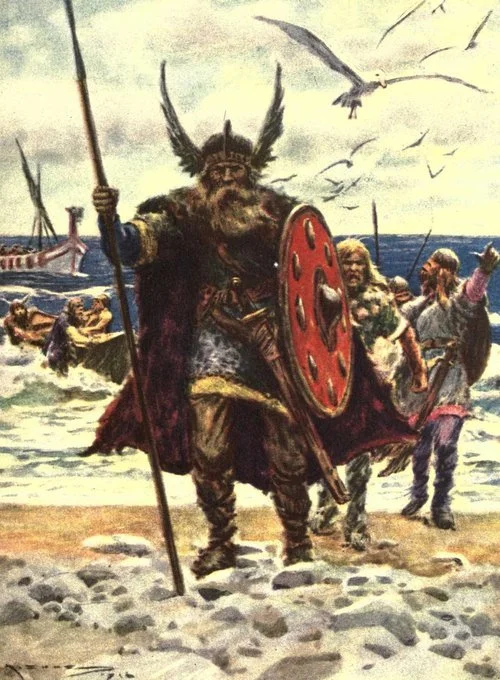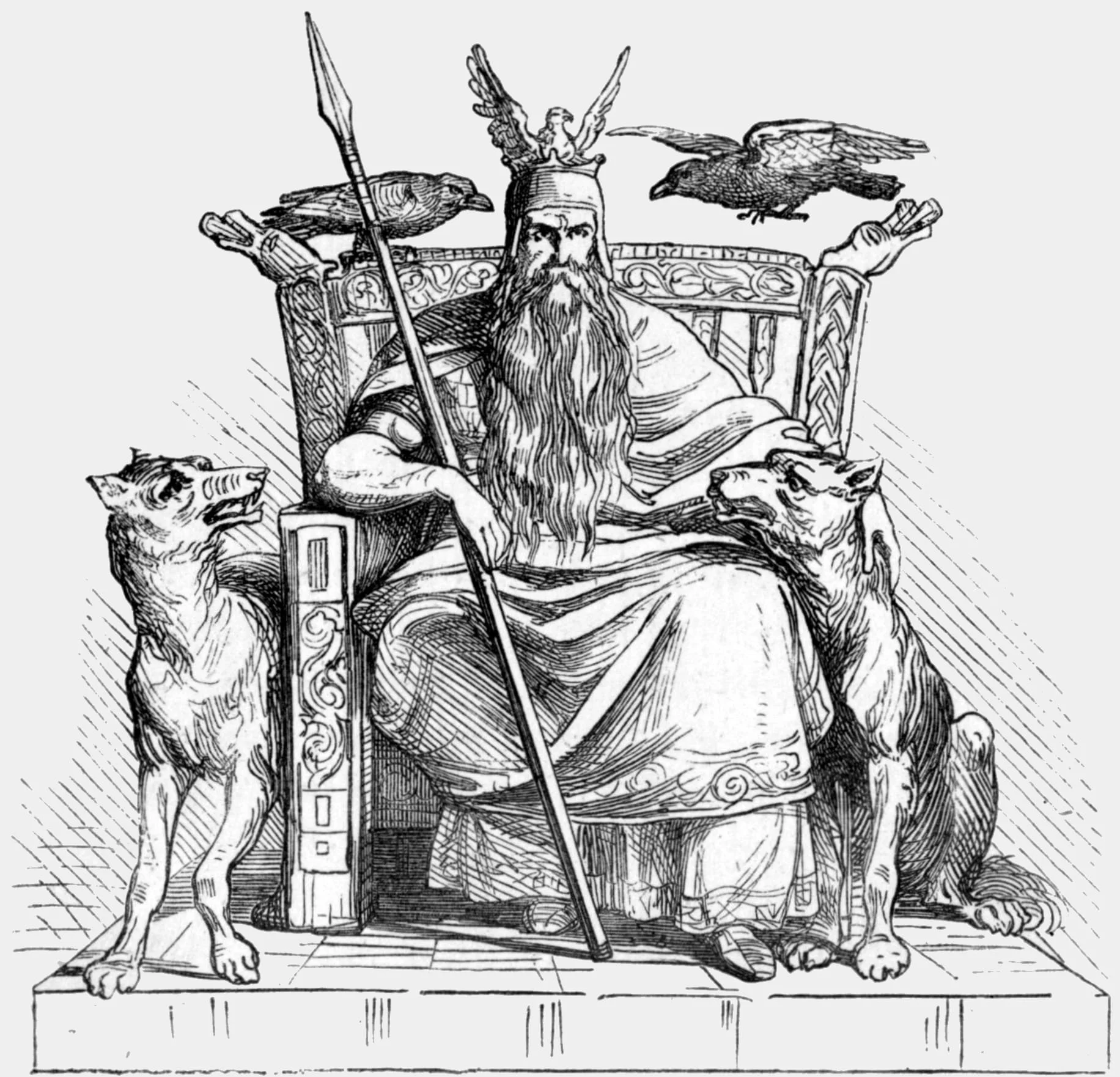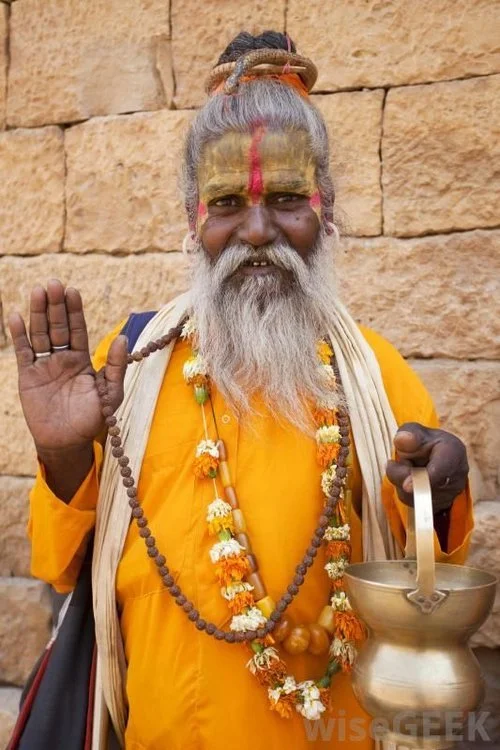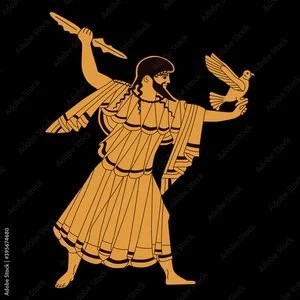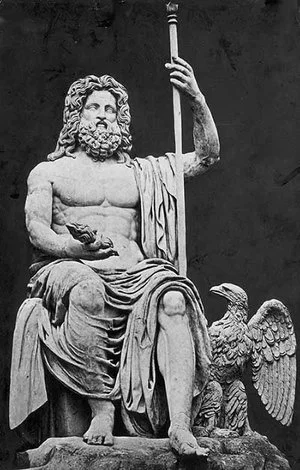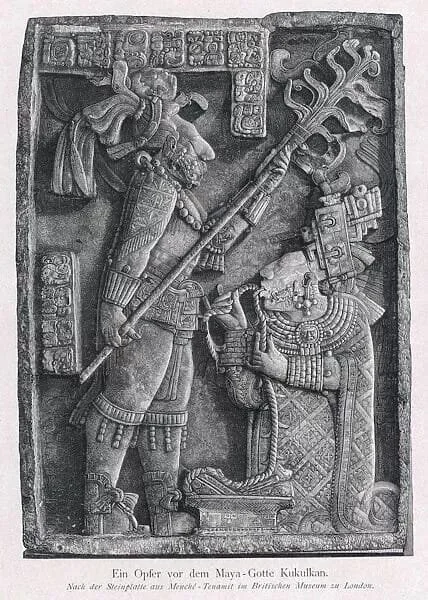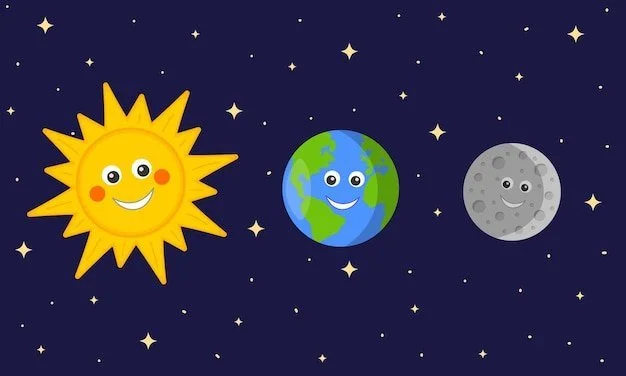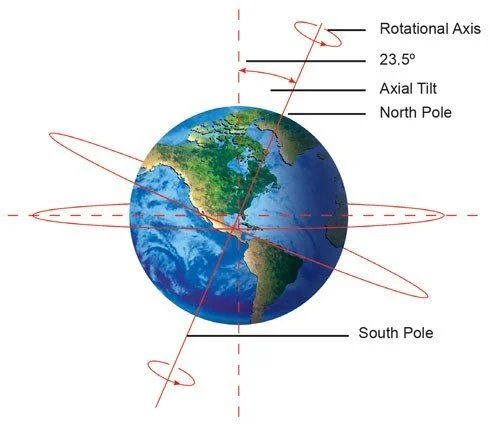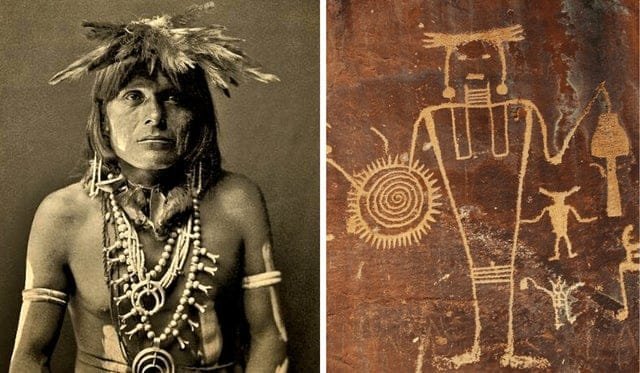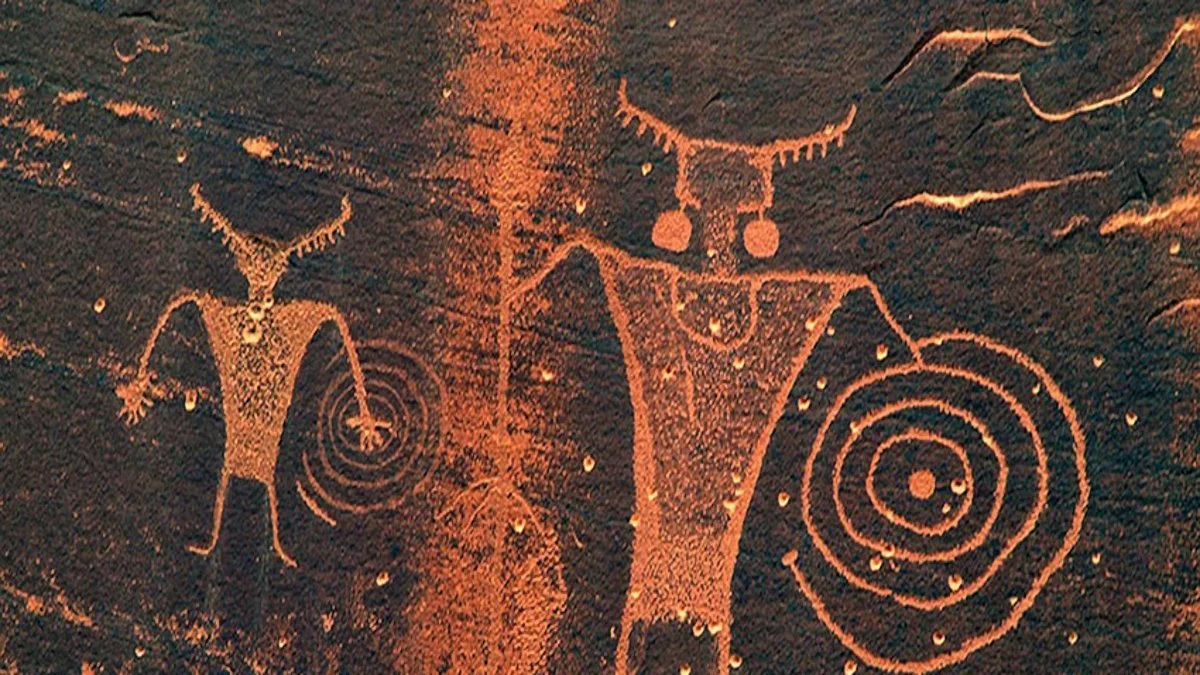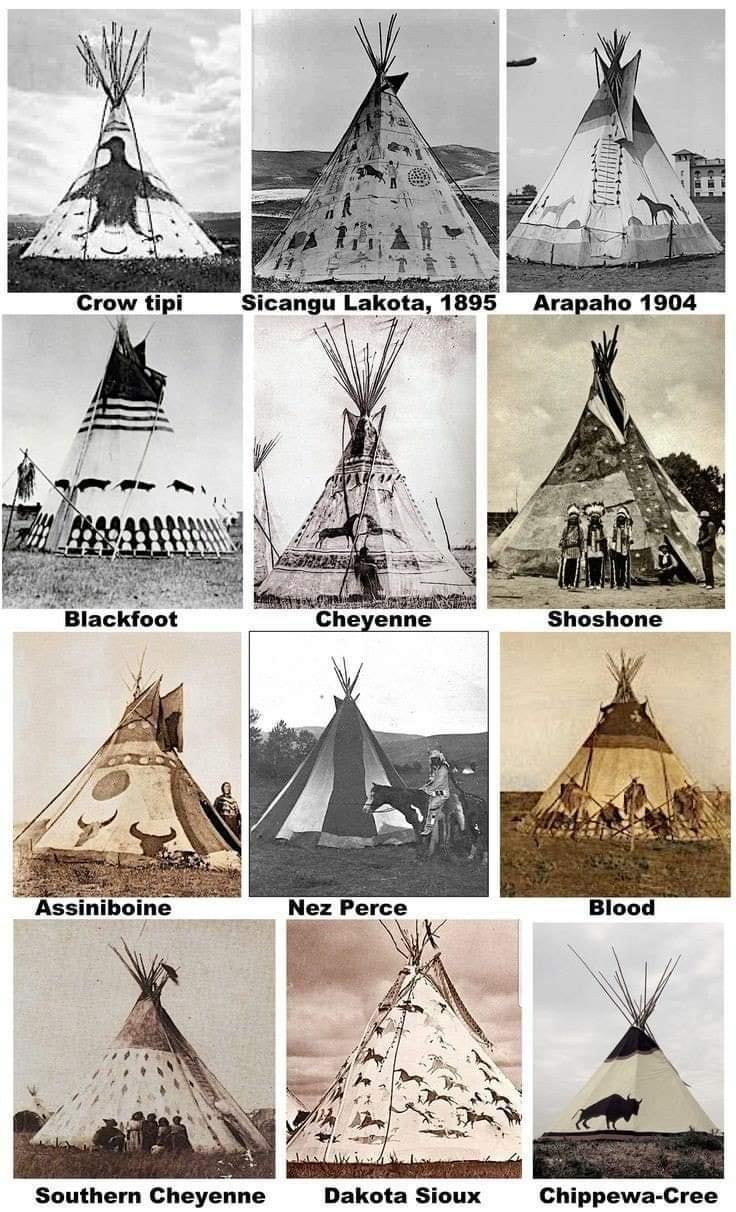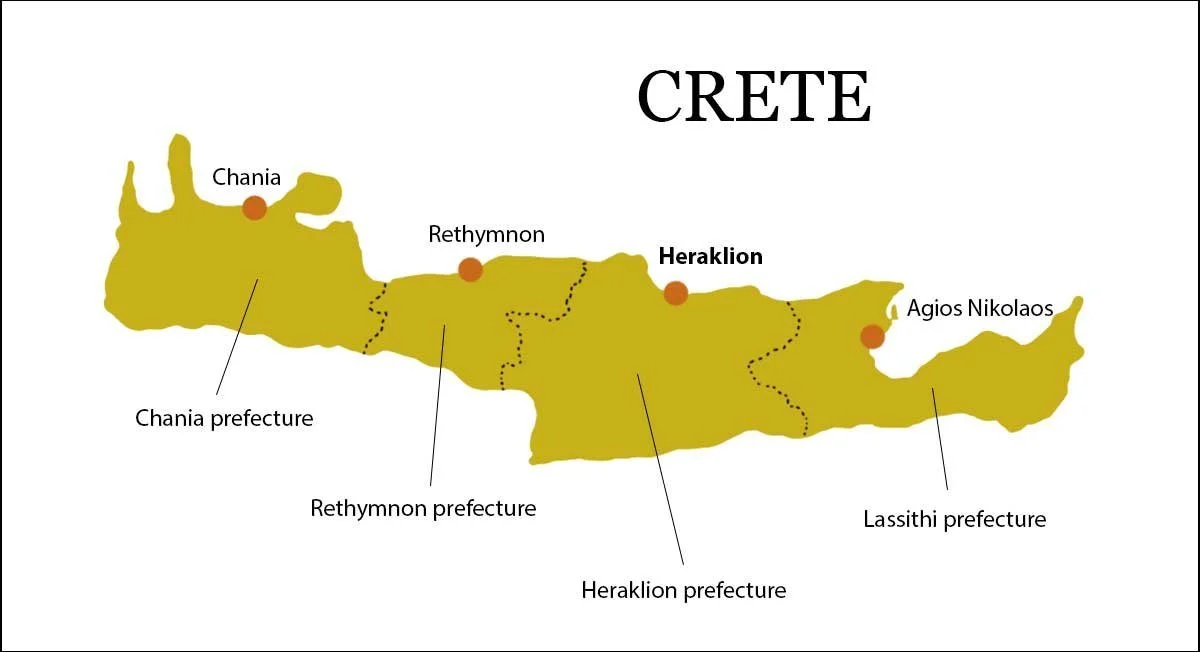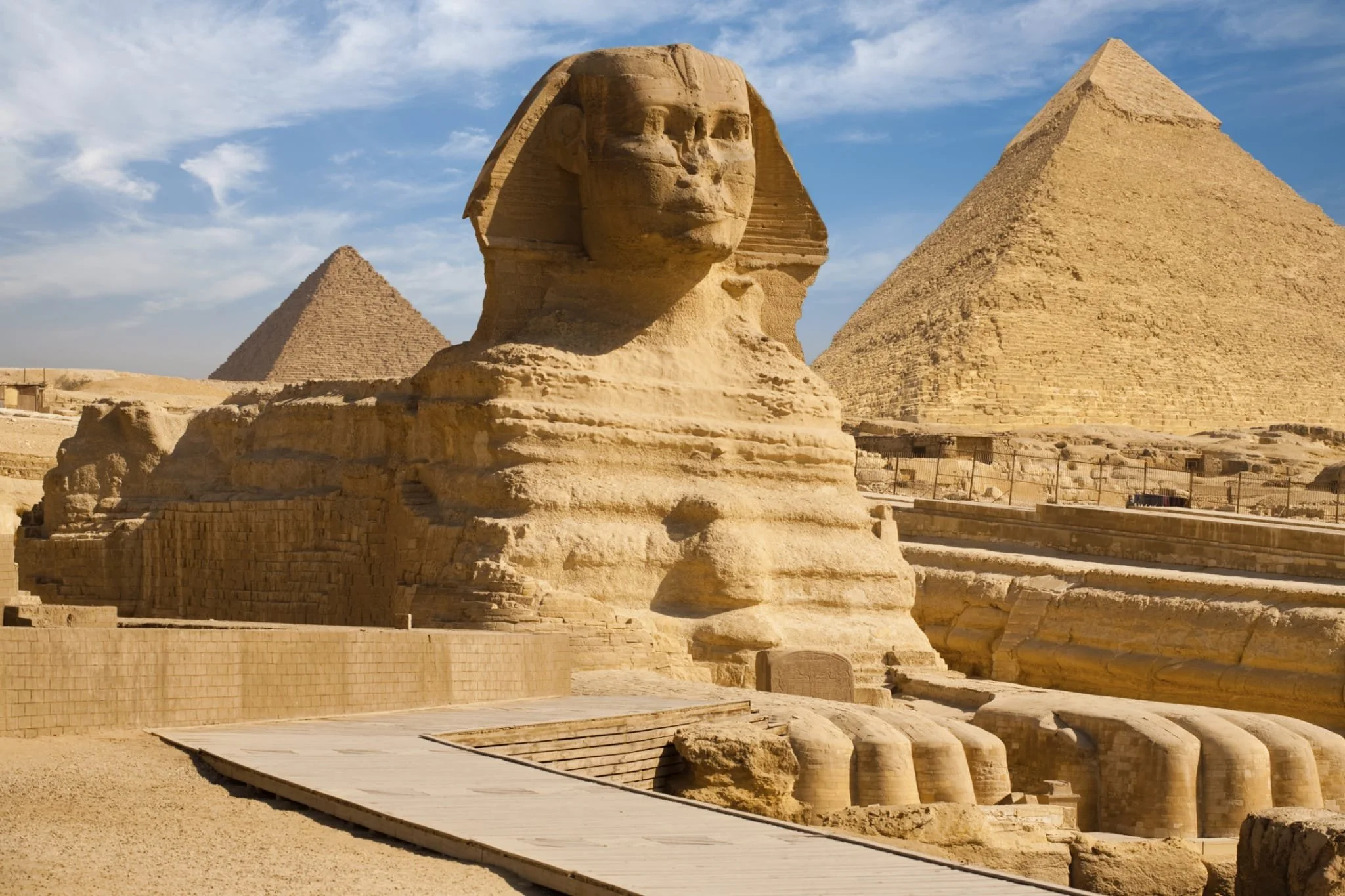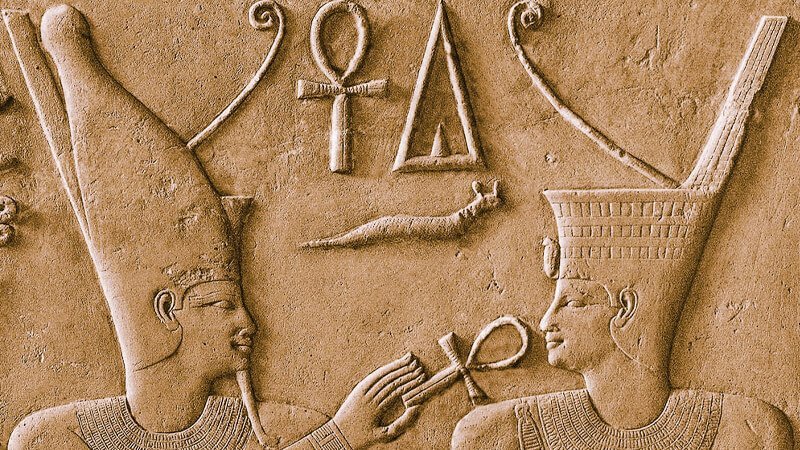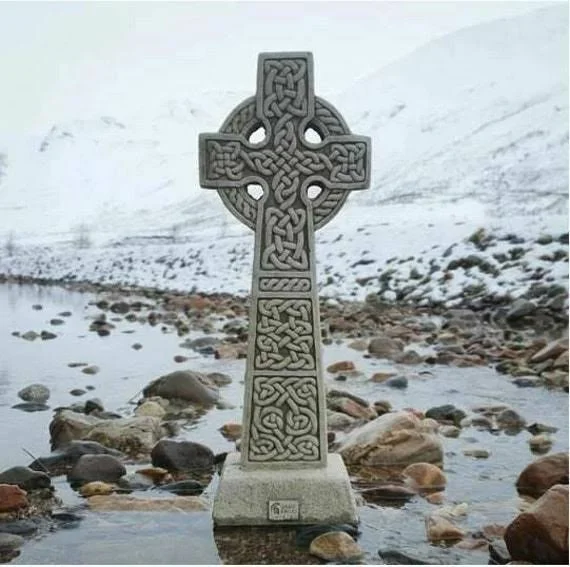The Old World Order : Part 4
Please re-read parts 1 - 3 which have been updated to include additional and more accurate information.
The second Ragnarök. We shall begin part four by picking up the story of the Aser as we left it in part 3, with them having left Hel to escape the 2nd Ragnarök, and now residing in the ‘Lummelunda’ caves in Visby, on the island of Gotland. We shall also remind ourselves that this second Ragnarök, or Destruction (occurring 10, 039 years ago) was caused by the melting ice of the ice-age (Altlandis), which was caused by the first Ragnarök (occurring 50, 010, 039 years ago), which was the earth itself tilting over in the first place (ending Paradise), and that this ice was set to destroy Hel for the second time. As previously explained; the Gulf Stream which had originally been the saviour of the Aser, allowing them to survive during ice-time had slowly been eating away at the ice-sheets in Scandinavia over the previous 50 million years, which were about to come down on Odenma and Hel. As mentioned, the Aser stayed on Gotland for almost 1000 years, its surviving limestone proving that it was not scraped back to the granite bedrock like the rest of Scandinavia, and an ideal place to escape the giant slabs of ice passing by. As also mentioned, they named the tip of Gotland that they landed on ‘Nóatún’ meaning New Yard or Ship Enclosure in Old Norse, and we remember that Noah just means New like ‘Nova’ or ‘Neu’.
When the Aser left Hel which had been surrounded by ice walls kilometres high for fifty million years, they had been operating a reduced-capacity breeding system of seven sons and seven daughters, during which; Bock and Svan had been renamed with the new titles of ‘Rafael’ and ‘Sara’. But after re-emerging from the caves after a few months they reinstated the original system of twelve and seven, and set about the standard protocol for repopulating the planet. Gubbe, the highest man was now known as ‘Gubben-Noa’ – the New Gubbe, and from this point onwards, as the newly emerged Aser were now also white-skinned - as opposed to populating the planet with brown-skinned people like they had before the ice-age, they were now known as ‘Aryan’. The term 'Aryan' simply refers to the fact that any offspring produced during this period were born under the sign of Aries, as per the breeding system. We can say with logic that the concept of so-called ‘white superiority’ or ‘white supremacy’ stems from here, as the top Pagan family previously known to the world as the ‘Heavenly gods’, and who previously had brown skin just like everyone else, were now suddenly these all-knowing, never-seen-before white people. [Now we need to communicate this message to all racists!]. The same white people, who as recorded in part 1, were now using their new-found freedom from the ice to travel the world and not only re-promulgate the original wisdom and ancient knowledge, but also their relatively newly developed farming skills which kick started agriculture worldwide. The official end of the ice-age, plus the so-called ‘Younger Dryas’ warming period now need re-examining and realigning with the correct timeline, dates, and each other - perhaps in another article.
During this thousand-year period the Aser spread from Gotland and repopulated the surrounding areas including ‘Götaland’ and ‘Götaborg’ in Sweden. These people would become known to the world as the Gothic tribes or Goths – ‘Goth’ coming from goat of course, and the well-established connection to the Aser, and our origins. This period was the real ‘agricultural revolution’ and the Aser spread and taught all the knowledge that they had gained, and techniques developed under the ice. This is how at least two of the countries which comprise what we now call the United Kingdom or U.K. got their names; an ‘Äng’ is a meadow which gave its name to Äng-land or England, which means land of meadows. A ‘Skot’ is a shoot which comes from the root of a plant when growing, or one ‘Rot-Skot’ (root-shoot), and this in turn gave its name to Scotland as part of the agricultural revolution of ten thousand years ago.
During this period of spreading and spearheading agriculture worldwide, in the areas of northern Europe, Scandinavia and Rusland (Russia) the land had been so damaged and scraped bare by the ice that extensive work was required to actually create new soil, before anything else could be done. Any land that escaped the big freeze of the 1st Ragnarök, had its vegetation destroyed by the waters of the 2nd and thus began the ‘Årike’ period. ‘Å’ as detailed in the ‘Alfarnas Bete’ of part 3 means River and is pronounced like the ‘A’ in ‘thaw’ which is more like an ‘O’ hence the extra accent mark above the letter in that shape. ‘Rike’ means Empire as in ‘Afrike’ - Africa. The rivers and lakes of Finland were created by the meltwaters during this period, and the Aser began to venture back there from their base in Gotland to plant trees. One of the many things they had created during their time under the ice was the pine tree, which was somehow developed from the tropical palm. [Note that in both species, the sun’s rays or ‘Stråler’ do not penetrate the leaves]. These are perfect for this situation, as they don’t require any soil to grow. The root word for pine is ‘Gran’, and pine seeds can be dropped into cracks in the rocks where the roots will penetrate and ‘eat’ the rock, hence Granite or ‘Gran-Eat’. The pine needles fall all year round, and suck up water creating soil. The trees can also latterly be cut down and burnt in a process known as Slash and burn or ‘Svedjebruk’ creating even more soil and fertilising it at the same time. A ‘Svidden’ is a field created by Svedjebruk, and looks to have influenced how ‘Sweden’ was arrived at as a name, but more on that later. The new soil eventually forms meadows or ‘Äng’ and leads us to the second part of the reconstruction of Finland following the 2nd Ragnarök, called the ‘Ängrike’ or Meadow Empire, this is then followed by the ‘Örike’ or ‘Island empire’. These are the three extra vowel sounds that sit outside of the main ring of the Alfarnas Bete; Å = River, Ä = Meadow, and Ö = Island. The belt of coniferous trees that is found in the northern hemisphere, close to the Arctic tundra, which stretches from the eastern coast of Canada, through Alaska (Al-Ask-Kar) and continues in a westerly direction through Northern Scandinavia and into Russia and Siberia, is the direct result of the skills of the Aser, and their reseeding programme. It is known by a variety of names including; ‘The Northern Coniferous Forest’, ‘The Taiga’, ‘Boreal Forest’ or ‘Snow Forest’. The reseeding programme would make sense of the giant grid-system, consisting of laser-straight lines over hundreds of miles, found in Siberia that even the Russian forestry department denies constructing.
Nine thousand and thirty-six years ago, or in BC 7013 the Aser ended their stint on Bockland, which was renamed Gotland after their departure and returned to the mainland where they began the rebuild of Raseborg (Rasepuuri) castle, the former residence of Ra and Maija (Ers & Mai) the king and queen of the planet which is located some 120km east of the old North pole. They had spent 997 years on Gotland with ‘Gubben-Noa’ as All-Father, this number was tweaked slightly when added back into the biblical Noah story, who was said to have lived for 950 years. The work took three years, and exactly 1000 years after the 2nd Ragnarök in 7016 BC, the Aser finally returned to Odenma. Here they rebuild cultural centres in the surrounding area such as Tavastehus – the entry point to Odenma as mentioned in part 3. ‘Tavastehus’ breaks down as follows; ‘Tavast-Te-Hus’ – Meet-Tea-House, almost like a modern-day service station before entering Odenma, and may even link to Tavern / Taverna perhaps. ‘Tavaste’ also means Face to Face, which is apt for a meeting. This is linked to the modern Finnish words of ‘Taivas’ – Sky / Heaven, and ‘Taivaaseen’ – Heaven (remembering that Odenma WAS heaven). Then, on ‘Oden’s Ö’, or Oden’s Island and the other seven islands immediately in front of Odenma (Helsinki) they also rebuild ‘Asgård’, ‘Midgård’, the ‘Asgård Arena’ and ‘Valhalla’. Here they also reinstate the original breeding and procreation system, and return to creating twelve sons and seven daughters. Rafael and Sara have their titles turned back to Lemminkäinen (Bock) and Svan, and the All-Father reverts back to his full title of ‘Bocken-Balgubben-Per’ or Gubbe for short. Back in business? Maybe…
Two kings. In previous articles when I detailed how the Aser family units worked, I also mentioned that any children produced over the quotas of twelve and seven were called ‘Mores’, they were still Aser, but had no function or title. During the migration from Gotland back to Odenma, two of these ‘more’ sons decided they’d had enough and split from the Aser entirely. Their names were ‘Sven’, and ‘Dan’, and they decided to leave and copy the model of the ten tropical kingdoms themselves, becoming two kings. If you make the hand gesture for expressing two, you make a ‘V’ with your fingers, and you can also say We which is derivative, and also meaning more than one, or a pair. This ‘V’ creates the sound ‘Vee’, which was written here as ‘Vi’, for these two kings were the original Vikings. Sven took himself a Svan called ‘Svea’ and together they made a kingdom in the Stockholm area, and called their capital ‘Uupsala’. This was now ‘Svenland’ or Sweden, and a new sperm-line called ‘Lingaet’, named after the Lingenberry - Whortle berry in English, is founded. His brother Dan found a queen called ‘Dagmar’, and together they travel south of Gotland founding ‘The Mark of Dan’ [Mark = land], or Denmark. Their capital is in ‘Jylland’, and another new sperm-line is created called ‘Polet’, and derived from the Van word for the same Whortle berry; ‘Puolukka’. Both houses had the berry as their symbol. The Viking era, is according to the mainstream paradigm, a mere three-hundred years, however – as this story shows it’s more like nine-thousand!
At this point in history we’ve progressed from there being a total of 30 white people on the planet, to three separate white races. The original Aser in Odenma are still speaking the Rot language, and still populating the surrounding areas with Van speaking Vaner people, who’s territories now surround the new kingdoms of the still Rot speaking Sven and Dan. The Aser are obviously still adhering to their original mythology based on the eight powers however, the two new ‘Arctical’ kingdoms develop their own mythologies based on the old, but with differences. These are known as the Viking or Norse mythologies, and of the original eight heathen powers only four remain. These are ‘Thor’, ‘Odin’, ‘Frey’ and ‘Freya’. For example; Hel has gone, as this was a place in Finland, and so has Bock, the head of the Piroet family from which they originally diverged. Tor – the heart has become Thor (Torshammer becomes Mjölnir), and Oden – the sun has become Odin, father of Thor. The name ‘Hel’ survived as both the inverted concept of place in religion, and as the ‘goddess’ Hel in the Norse mythology, said to preside over the underworld realm of the same name, and the supposed daughter of Loki.
These two kingdoms would spread and repopulate much of northern Europe and Scandinavia; The descendants of Sven and Svea populated Sweden, Norway, Iceland, Scotland and Ireland. While the descendants of Dan and Dagmar populated England, Germany, the Netherlands, Belgium, France and parts of the Mediterranean. In all of these places the people count using a twelve-based numbering system, coming from their Root-speaking founding fathers Sven and Dan. Other countries and languages that use a ten-based numbering system reflect that their founding fathers originally spoke the Van language, and went their own way during the ice age. It’s interesting to note here that the so-called ‘Celtic’ languages like Welsh use a ten-based numbering system, which shows that this language and its predecessors did not originally come from the shores of the British Isles. This idea flies in the face of current mainstream wisdom, which has the Welsh as the original inhabitants of these isles, but the language says otherwise. Originally speaking ‘Brittonic’ an earlier variant from which Welsh and Cornish are supposed to have developed, but bringing with it many tell-tale connections with Latin, for example ‘Pont’ or ‘Bont’ meaning Bridge – The Pope, or ‘Pontiff’ being the bridge-builder. That is unless the ancestors of the Welsh also survived the freeze somewhere and kept their pre-ice-age Van or Van-based language and counting system, but there is no evidence for this. For clarification here are some examples of the counting systems of different languages; in English the word-form changes after twelve to thirteen in a form which resembles 3+10 making it a twelve-based and therefore root-based counting system. In Welsh the word-form changes with eleven which is ‘Un-deg-un’, which translates as One ten and one or 10+1, making it a ten-based counting system and therefore ultimately derivative of the Van language. The Swedish changes at twelve, and the Finnish at ten, but you’d think it would be the other way around being since Rot was spoken in Odenma (Helsinki) which is obviously in Finland not Sweden? This is due to the events of the 3rd Ragnarök, which we haven’t got to just yet, however it meant that the root language only survives in pure form in the island archipelago just south of Helsinki, and is known as Finnish-Swedish today. Much to the annoyance of some Swedes this means that Swedish is actually a variant of Rot, but as the events of the 3rd Raganrök and therefore also the long history it erased have been removed from mainstream history, they’d have had no idea anyway, which was exactly the plan. This will be clarified in future articles. As Swedish is ultimately a variant of Root, the Finnish-Swedish people of Southern Finland call it ‘Ruotsing’ – Root-Sing, this reflects the Swedish accent which tends to go up and down a lot with its rising or falling pitch, and also has two different tonal accents, whereas the Root language is more flat and stable.
Brave new world. Returning once more to Odenma, and the Aser now have a huge mission to undertake, alongside repopulation of ringlands established in the surrounding areas, they must also now re-connect with the rest of the planet. The ten brothers or ‘Tentinio’ of the Piroet family, the ten sons of Bock / Lemminkäinen, the second to eleventh, are the men for the job. They are sent out around the globe to make contact with the ten tropical kings, and each of them being a male (Han) from Odenma meant they were ‘Han-Odens-Man’ or Hanoman – this name survives in India as the monkey-god ‘Hanuman’, with the ‘u’ being pronounced the same as the ‘o’ would have been in Root language. These Hanoman are messengers from Hel – the Root / Swedish word for messenger is ‘Bud’ (pronounce the ‘U’ like the ‘oo’ in ‘brood’) which means that each of our ten brothers was also a ‘Bud-A’, - a Messenger of the Aser (Buddha). ‘Gautama Buddha’ or ‘Siddārtha Gautama’ was a ‘Sakya’ prince, also known as ‘Sakyamuni’, his father was ‘Suddodana Tharu’, and his mother ‘Maya Devi’ from a royal Hindu family. But that is the modern interpretation coming from Buddhist teachings – we know this man actually came from what we would today call Finland – he is recorded as being ‘the son of a king with golden locks’ and you don’t get those if you have Hindustani heritage ordinarily. The name ‘Sakya’ if broken down could mean ‘Sa-Ky-A’ – ‘Receive-Key-Aser’, remembering a ‘Kyy’ or ‘Ki’ is also a penis, so could mean something to do with the offer-ring. This theory seems to hold up when looking at the second half of the expanded version ‘Sakyamuni’, which looks exactly like ‘Mun’ + ‘i’. Furthermore, it also seems to resemble ‘Suck-Your-Mun-i’, which would tie in nicely. His fathers’ name begins with ‘Su’, which can quite often be a prefix pertaining to Finland – Suomi, and his mother was named after the Queen of the planet – a boat-load of clues as usual. Many messengers were sent out over thousands of years, which explains the many ‘reincarnations’ of Buddha. [More detail on Re-legions to come]. Here, an extremely old rhyme or ‘Ramsa’ tells us about theses messengers;
Han Odens Man
Kom Som Asernas Bud
Til Asien Med Odens Visdom
Som Gjorde Bocken Til En Bra Man, En God Man
Som Skapade Goda Mänskior, Fylgior, Valkyrior.
Translation;
Men from Odenma
Come as messengers from Aser
To Asia with Odens wisdom
That made the Bock a good man (knowledgeable), and a good man (good inside)
Who creates good people [with] soul and Valkyrie.

We note here that a ‘Bra-Man’ meaning a Wiseman or knowledgeable man is where the term Brahmin originates in Vedic culture that ended up designating the priestly class (Purohit, Pandit or Pujari) and spiritual teachers such as Gurus or Acharya. One brother was originally sent to each tropical kingdom, with the main message; that the ice had finally melted and that the ‘Heavenly Gods’ were still there. That the procreation system in Hel was now operational again, and that the Bock in Odenma could once more be All-father to the whole world. They spoke of their inventions and discoveries in agriculture, animal husbandry and other technologies and techniques including how to extract metal from rock (Smelting), and the arts of combining different metals so that they didn’t corrode and could be used for different things (Metallurgy).
Remembering how our ten tropical kingdoms were arranged; Crete was the administrative centre and seat of two systems, as the original prime meridian sliced it exactly in two. ‘Rasul’ / ‘Rasuul’ or ‘Rasol’ (say ‘Rah-Sool’) was king and All-father of the eastern side of the Island, and territories to the east, and ‘Sultan’ was the handed down title of the king of the western side, who ruled over territories to the west. Rasul operated a ‘Jupiter’ based mythology [pre-Roman], and the Sultan operated a ‘Zeus’ based [pre-Greek] mythology with their respective pantheons - remembering of course that the model of all these ‘gods’ came from the original Piroet family of Aser [from whom all remaining European royal houses are descended – and the true origin of ‘Divine right to rule’]. In the kingdom east of Crete the messenger was known as ‘Dionysus', and in the kingdom west of Crete the messenger was called Mercury (the other side called him Hermes).
At this stage we do not know the names of any of the other messengers, I hope to figure that out with further research. But, the ‘Creator’ gods from central and south American lore have names that are tantalising when you understand the sound-system; the Aztek have ‘Quetzalcoatl’, the Maya have ‘Kukulkan’, and the Inca have ‘Quechua Wiraqucha’ (Viracocha). Sharp readers will have already noticed the abundance of ‘Ku’ and ‘Qu’ sounds in the names. In the Van / Finnish language, the sound ‘Ku’ means The Moon, and in Root, ‘Ra’ is the moon – but ‘Ra’ is also the King. So the use of the sound ‘Ku’ in all the names suggests a King, a ruler or at least some kind of leadership and guidance. Some key things relating to the moon worth remembering here are; that the moon signified the information side of things, as opposed to the sun signifying breeding, that ‘Ku’ or ‘Q’ also pertained to mathematics, and that the cycles of the moon are involved in traditional agriculture, for example in planting crops – so the logic of the moon had many applications. One alternative form of the name ‘Viracocha’ is; ‘Apu Qun Tiqsi Wiraqutra’, which similarly holds more possible clues. Firstly, ‘Apu’ looks very similar to ‘Apa’ – Ape, which also conjures up thoughts of ‘Aboriginal’ as it has been said that the ‘Abo’ part is also relating to Ape – the ‘Apa-original’. Secondly, we have two ‘Qu’ sounds and a ‘Ra’ at the end, more positive confirmation of leadership titles. These messengers never came home, they stayed and moulded the cultures of each.
Here are our pale skinned, bearded ‘Civilising Deities’ as recorded in the cultures of these areas, as bringing the gifts of agriculture, civilisation and technology - and now we have reasons why they were white, where they were coming from, plus why this information was being redistributed. This information, and that of the true nature of Altlandis, rather than ‘Atlantis’ fills in and re-aligns the work and research of Graham Hancock et al – we know who the ‘Sea Kings’ were now, and we know what connected the previously global civilisation, and who ran it. It’s also interesting to look at some of the words and names at play here; Saga details ‘The Three Red Races’ of the Americas (previously known as India) as being the Aztec, the Inca and the Maya – three of the ‘Ten Tropical Kingdoms’ of the ice-age or Altlandis. But we can also see that the names also seem to be related to our distant past; the first part of Aztec – ‘Az’ is extremely similar to the sound ‘As’ meaning Aser. The second part ‘Tec’ isn’t as instantly recognisable, it may be a corruption of ‘Tik’ meaning time, or it may be ‘T’ for Tor + ‘Ek’ for Oak. Maya is the simplest to recognise; they are named for the queen of the Aser, the queen of the planet, the first born daughter of the family Maija / Mai / Maya. Lastly there are the Inca or Inka, which is a fragment of Lemminkäinen, the Van name for the twelfth son, also known as Bock (also Balder) in Root. The Inca lived in Bolivia and Peru, and whilst the former is named for ‘Simon Bolivar’, the latter seems to be saying Father-Oden, or ‘Per-O’ [Pär-O], remembering that an O is pronounced ‘Ooh’.
Return to Hel. We must return now to BC 8016, the date when the Aser finally migrated back to their ancestral home of Odenma, which is present day Helsinki. This date also marks the official end of the ice-age or Altlandis as recorded in Saga, giving a period of exactly 50 million years. This date is also exactly 1000 years after the 2nd Ragnarök, and when Sven and Dan leave to become the Vikings. The so-called ‘Great flood’ or ‘Great deluge’ must have been around this time period, as this is logically caused by the melting of the ice from the ice-age, rather than the prevalent meteorite theory. It is simply the waters of the earth redistributing themselves after being frozen. It’s worth noting the man-made climate change scam now, as here we have the truth; the climate IS changing, and the ice caps ARE melting – AS THEY SHOULD BE! The ice is not supposed to be there, our mother is shedding her load in preparation for returning to her natural position; straight up with the pole in-line with Polaris, and once again perpendicular with the sun*. This will bring about another golden age and a return to the global tropical and sub-tropical climates of the Paradise time, but whether our minds are ready for such an event is debateable. So the real logical reason for the powers that be to be manipulating weather, spraying in the atmosphere and such like is that it is delaying the inevitable. Blocking out Oden the sun only delays the melting, which delays the tilt and keeps them in charge that little bit longer – but, they know full well that they cannot delay it indefinitely, nature always wins, something to keep in mind in these dark times.
* Let’s inject some further logic here along with simple observations all people can make. The one sun (solo) is not 150,000,000 km or 93,000,000 miles from earth, nor is it 400 times larger than the moon. So unless you believe in ridiculous unprovable coincidences rather than your own eyes, this means that the sun and moon (solo and mono) are roughly the same size; 3474.8 km in diameter if official sources are correct, and they are both roughly the same distance from earth; with the average distance to the moon being 382,500 km or 238,500 miles, again, if official sources are correct. If the sun were 93 million miles away, we wouldn’t be able to observe its rays triangulating on clouds and we certainly wouldn’t feel its intense heat having passed through the supposed ‘vacuum’ of space. They wouldn’t fit so neatly over one another during an eclipse either, so a monumental coincidence was concocted to explain this. As explained in previous articles; the sun and moon are ‘Tor’ friends, and the moon reflects the light of the sun, which is a form of ‘Ra’ (energy transfer). The sun ‘Pan’, in a ring ‘O’ with the moon ‘Ra’ look down on the land ‘Ma’, or Panorama. This is why that section of the alphabet runs R>S>T or Ra-Sol-Tor.
Nineteen eighty-four. The final significance of BC 8016 is that it makes the year AD 1984 exactly ten-thousand years after ice-time, which is no coincidence as this is both the year decreed by the Bock family that the living Bock (Ior) would give the story back to humanity, and the year when the prophecy from the ‘Story of Kristina’ should have taken place. An Aser lady, or Asynior, possibly a witch or a Siennare made one future prediction. It was predicted that when the global procreation system was reinstated in Odenma, it would take ten-thousand years to come to fruition. By fruition it is meant that through the offering and breeding systems every person on earth would end up with full soul power just like a member of the Piroet family, which would finally enable one man and one woman to make a child that is whole both inside and out without the need of the contribution of the other twenty-thousand or so people. It is clear that this did not happen, the Aser may well have had their myth, but it seems the rest of the world - along with its fifty-million-year development without the influence of the original gods - had other ideas. It’s also no surprise that the date of 1984 was inverted to give it a negative connotation for humanity.
With these dates set out, we can clearly see four world ages or time periods of life on earth; the first is the period after the earth’s formation during which nature develops, which doesn’t seem to have a name so we’ll call it the pre-Paradise period. The second comes about with the birth of Freij and Freija; the Paradise, and is ended by the planet tilting over which causes the ice-age, which means the third world age was Altlandis. The fourth is the epoch we still live in, let’s call it the post-Altlandis period for now, and if the planet tilts back to its correct position that will be the fifth. We can draw comparison here with the Yuga world ages of Hindu belief, in which it is said that there have been four, and that we are living through the fourth right now; the ‘Kali Yuga’. However, the numbers involved don’t seem to line up with dates from Saga. For example; the Kali Yuga is supposed to last for a thousand ‘Divine years’, and a divine year is supposed to equal 432,000 earthly years, which gives us 432 million years, which if taken as a whole would encompass everything going back past the ice age, including most of the paradise time. In the Hopi Indian tradition of North India “America”, things line up a bit better; the Hopi postulate four world ages and that we are currently living through the fourth. The first was a paradise where humans and animals coexisted in harmony, yet was destroyed by fire. The second age was according to the Hopi, a time where humans had no respect for nature, and was destroyed by ice, glaciers, or extreme cold specifically triggered by a pole shift – sounding familiar here. The Hopi were saved by the Ant People who kept them safe underground, and at the right time they ascended a ladder into the third world. The third age or world was destroyed by water, which also lines up with how we now understand things, apart from the part where they’re saved by the ‘Spider Woman’ who binds them to reeds which float to the dry land of the fourth world. According to the Hopi, the fourth world is ending and the fifth has already begun.
The name of the tribe itself also appears to be constructed from Root language; ‘Ho’ is the sound produced by the letter / mark of H, and means Hel at the old North pole. Plus ‘Pi’ as we already know means a ring or a circle. In a brief attempt to analyse this we can look at what we already know; there was a Pi or ring in ‘Ho’, or Hel, it was the centre control ring at the top of the planet from which the Aser created and guided all people. Other meanings of Hel are; ‘Home’, ‘Worthy’, ‘Clear’ and ‘Complete’, so there we have several other possible meanings of Hopi. Worthy of note here whilst we discuss Indian, or Native American tribes and cultures is that; the Hopi themselves claim distant relation to the aforementioned Aztec which backs up Saga. The traditional dwelling of most tribes was the ‘Wigwam’, ‘Tipi or Tepee’ which if we break down reveals something rather interesting; the sound ‘Ti’ or ‘Tee’ in Welsh ‘Tŷ’ means House, and a pee or ‘Pi’ is a circle which is indeed the shape of the base of a Teepee. It’s a great example of how we can show that sounds across the globe connect on different levels. We can use two different languages – one Latin-European based, and the other the oldest language on earth from Scandinavia - to arrive at the perfect translation and description of ‘round-house’.
Native Americans had no temples for their beliefs, or did they? What do we already know about temples from Saga? We know that a temple (tempel) was accessed exclusively be men, and that conversely the women had their chapel (capel). In Native American culture they have the ‘Totem Pole’. We already know that a pole is masculine, and in line with its direct association with the penis also being a pole, it’s obviously fitting that men primarily handle it. But if we break down the sounds and shift one over slightly, a curious thing is revealed; Totem pole>> To tempole>> To temple… The pole IS their temple, and was traditionally cut, carried and carved by men, some of which are also kind of T-shaped with the addition of wings. A ‘T’ shape could then indicate ‘Tor’, the masculine version of which is a man’s true heart, located on his pole of course. Mainly conjecture at this point, but interesting nonetheless. In Canada there is a legend among the ‘Heiltsuk’ tribe, who for thousands of years have maintained that they survived the ice age in an area that didn’t freeze. Whilst on the surface the story claims that these events took place in an area around Triquet Island, on the western coast of their territory in British Colombia, where in 2017 a hearth was unearthed and dated back some 14,000 years – however, could it also be inspired by some ancient tales of Odenma from roughly the same time period? It’s rather a coincidence that the beginning of the name ‘Heiltsuk’ is very similar to Hel, and the rest also contains ‘Su’ denoting Finland – as we have seen all over the world. Could their original ancestors who took refuge there have actually been related to one of the Gothic tribes, and if so how long did they stay there? Or was it that they had knowledge of the ‘Hel of Suomi’ and it somehow ended up as a folk-memory that got reintegrated with their own story?

Cretins? We return to two of the other ten tropical kingdoms, located in the Mediterranean that we mentioned earlier, and our two king systems of ‘Rasul’ and ‘Sultan’ on the island of Crete. Let’s have a quick ancient geographical recap here; the ancient and original ‘Prime Meridian’ ran from the old North pole of ‘As-Hel’ or the centre of Odenma (Helsinki) down to ‘Hel-As’ or Greece. As it crosses the waters of the Med it splits Crete exactly in two, and as it continues down into Africa it is still visible as the border between Egypt and Lybia. In AD 1675 the prime meridian was sold by the Dutch to the British, moved back an hour to London, and Greenwich meantime was created. This means that the original timescale sat directly between GMT and CET or Central European Time which are two hours apart from each other. So the eastern and western hemispheres were ruled and administered by Rasul and Sultan on Crete, as mentioned this shows us that ‘Greeks’ and ‘Romans’ were contemporaries rather than one following the other. For a long time, the two kings shared Crete until at some point around 6000 years ago, inspired by Sven and Dan the Vikings they leave the island and establish capitals to the north; Rasul in Rome and Sultan in what is today called Istanbul (previously known as Constantinople and Byzantium). These power structures would eventually become ‘The holy Roman empire’ which also became the Catholic Church, and the Eastern Orthodox Church respectively, but we’ll pick that story up another time.
When Rasul and Sultan left Crete it left a knowledge vacuum in the Mediterranean and North African areas, and also left them without a breeding system. The people of the area sent a message to Hel asking for help, and the Aser obligingly sent an emissary; one of the more than twelve sons of Bock. His name was ‘Perora’ or ‘Per-Odens-Ra’ and he makes the journey from Odenma down to ‘Kem / Khem’, which is not only the old name of Egypt, and the root of the word ‘Chemistry’, but is also a Bock! The ancient Egyptian deity ‘Khem’ / ‘Min’ / ‘Khnum’ is depicted as a goat-headed man with a large, straight erection, exactly the same shape a Lemminkäinen or breeder would have. As ‘Khem’ or ‘Min’ he was the god of reproduction, as ‘Khum’ he was creator of all things, the maker of gods and men. Researcher and Author Graham Hancock mentions an ancient Egyptian legend in his works that tells a similar story to the legends of the Americas, in that, white skinned ‘gods’ came with incredible knowledge which kick-started their civilisation. Here is some positive confirmation of the legend, as Saga records that ‘Perora’ becomes the first ‘Pha-Ra-Oden’ or Pharaoh, which is almost like saying ‘the king sent by the All-father in Odenma’. The first Pharaoh had blonde hair and blue eyes, just like his relatives the Buddhas.
He brings with him all the advanced knowledge of the Aser; mathematics, navigation, agriculture, geometry and construction techniques. He brings never before seen creatures developed in the Arctic like sheep that can produce wool, and new plants that will produce other materials like cotton and linen. According to Saga the principle river of northern Egypt (known as lower Egypt in the dynastic period just to confuse you) which we know as the Nile was originally called the ‘Aura’, it furthermore details that during what we might call Egypts’ agricultural revolution in this period – ‘Lin’ from Linen is reversed giving ‘Nil’ or Nile, and the river is renamed presumably due to the use of its waters in cultivation. Egypt is of course famous for its cotton and linen. Another of the concepts he brings, as part of geometry and mathematics is Pi-Ra-Mid or ‘Pyamid’. Let us quickly remind ourselves of Pagan logic; a circle, a pole and a dot or point are not only the basis of all life and reproduction (putting pol into pi gives us more pi-pol or people), but also the basis of mathematics (putting a pole represented by the letter ‘P’ into the centre of a ‘Pi’ or circle represented by the letter ‘O’, and allowing the sun to strike gives the letter ‘Q’ [O+P=Q] just like a sundial, and is also a two-dimensional representation of a three-dimensional concept. Pyramid is yet another iteration and expression of this central concept; ‘Pi’ is the circle, ‘Ra’ in this instance is the pole or ‘Radius’, which is measured from the centre point, or middle. So ‘Pi-Ra-Mid’ is ‘Pi-Radius-Middle’, and another expression of universal logic. Remembering that the ‘Pi’ in pyramid is feminine, means that pyramidal structures are all feminine, it is a common mistake to pronounce the upward-pointing construction as obviously masculine. A masculine version would point downwards, and would be called ‘Ky-Ra-Mid’.
The cap-stone or ‘Ben-ben’ stone (which is missing from the Great Pyramid) is linked with the ‘Bennu’ bird, which in itself is linked to the Phoenix which was associated with the ‘Sex Häxor’ or the Witches of Odenma, which again shows an overall feminine connection. We can tie this back the other way to complete a ring of logic via ‘Pyro’ meaning fire, which starts with ‘Py’ which is essentially the same as ‘Pi’ regardless of spelling, with which the Phoenix has direct association and fire of course being a female gift. In Hebrew and Greek, the word ‘Phoenix’ means Palm Tree, which we can also link to fire via the ancient mid-summer tradition of placing a metal Swastika atop a decapitated palm using a spike during paradise-times – the top of the tree would be placed back on the Swastika, and as described in previous chapters the ‘Swavel’ in the vessels on the arms would be lit making it spin.
Yet another meaning of ‘Phoenix’ or ‘Feonix’ is regarding Axes – the iconic double-edged axe which is seemingly prominent in mythological motifs is said to originate from the Minoans of Crete – which was a largely matriarchal society - where it was called a ‘Labrys’ in reference to Labia, and in the shape of a butterfly with its ‘wings’. In Minoan society it was a symbol of their goddesses, and was the weapon of choice for Amazon warriors, further solidifying the female connection. The Latin term for this object was ‘Bipennis’ (no sniggering at the back), which obviously looks like it means a pair of penises – but means two-winged, yet seems to draw on the logic of the head, or ‘Pen’ of the penis too. This may be a form of inversion, as Latin likes to invert some meanings of sounds from the past. An axe in Root or Swedish is an ‘Yxa’ or ‘Yx’, and when forging the blade, it emerges from the furnace glowing and shining with red, yellow, purple and green hues which are caused by changes of the oxidation state, which changes the colour of the light absorbed by the metal – and it has two ‘wings’ and a long ‘tail’ – the handle. If you’ve done a good job with your blacksmithing then you might produce a ‘Fin yxa’, or Fine Axe, and the blade can be ‘resurrected’ by re-heating and therefore live for hundreds or thousands of years. Furthermore, if the blade is made of gold, then it can be considered to be immortal!
The Pharaoh set up a new breeding system, which was modelled after the king systems used elsewhere outside Odenma in the Ten Kingdoms. His eldest son would become the next Pharaoh; embodying both the positions of king and breeder (traditionally split between the first and twelfth sons in the original system). He would choose the healthiest and most beautiful woman in the kingdom to be his queen, and their eldest son would in turn become Pharaoh. But in the same fashion as the original system, he also mated with a harem of other women, the selected sons of which would mate with the women from the caste below and so forth. Among the gifts that the Pharaoh brought to his new people were the techniques of embalming. The reason that ancient Egyptians preserved and mummified their dead was that they were no longer sure whether the traditional method of cremation and the be-leaf system would send their souls back to Lemminkäinen via the centrifugal forces of earth. They still knew and understood that the soul resided in the body, so they mummified them instead to preserve the Fylgia in the hope that they could be properly released in the future.
Wank like an Egyptian. A relic of the offering system of the old world remains in Egyptian iconography to this day, an item whose exact function has been guessed and speculated on countless times. It has even been speculated to be some kind of energy device that Nikola Tesla supposedly built a version of, none of which are correct. The item I am referring to is none other than the Ankh, which was used in the past by men to receive an offering of sperm without touching the other man – guess what goes through the hole? In a previous chapter I described how the military would take offerings using a thin rope or cord, which over time got stained more and more yellow with saffron, indicating higher levels of offerings received – the origin of Aiguillettes from military uniforms – but when the offering was being made the rope was tied into a knot called a ‘Fångögla’, which was the same shape as an Ankh. ‘Fång’ (say ‘Fong’) – to Catch, and ‘Ögla’ – the Knot. This device is the origin of the word ‘Wank’; the ‘W’ sound is signifying Oden the sun, who’s ‘Visdom Vatten’ - Wisdom Water or ‘Livets Vatten’ - Life Water is received via the offering using the Ankh. We had been previously taught that this word came from a time when Britain was at war with Spain, and king ‘Juan Carlos’. It is beyond the scope of this article, but this author firmly believes that huge discoveries are yet to reveal themselves on, or rather beneath the Giza plateau which most tourists simply walk straight over without giving a second thought to what’s beneath. It is however the authors logical contention that the Sphynx was originally a large cat before being re-carved with the head of a Pharaoh. The latter part of the word-form is highly suggestive of a Lynx, which represented the power of nature to ancient Pagans, and if we rewind the ‘precessional clock’ the monument also points to the house of Leo in BC 10,500 – beginning the age of Leo.
We’ll conclude this episode with some information on symbology, terminology and education. We have previously detailed how the swastika was the symbol of Hel, it was known as ‘The Life Wheel’ or simply ‘The Wheel’, which the church turned into De-Vil or Devil. It symbolised the breeding and information systems which were administered and rolled out across the planet from the old north pole, which was the Pagan / Heathen global administrative centre (one ring to rule them all). The central ‘Ringland’ at the old north pole was called ‘Odenma’ which means Oden’s Land or Land of the sun, which works on more than one level as prior to the tilt the sun would never set in Odenma, it created another ‘Pi’; a golden 24-hour ring of sunlight at the top of the planet.


Similar to the Swastika, except without the crooked arms, is the other well-known symbol of the cross with equal-length arms, for example; the cross on the Swiss flag, when placed within a circle this can sometimes be called a ‘Celtic Cross’ which is generally considered to be older than the standard Christian cross, with Pagan origins. This is well-founded. Both the Swastika and the equal-armed cross feature four spokes or lines which converge in a centre; this is representing a birds-eye view looking down from above at the top of the planet before the tilt, and therefore representing Hel. The four spokes are the meridian lines, which also represent ‘The four corners of the world’, and also symbolise all that emanated from the real ‘Fountain of Youth’ – the All-father system at the old North pole. The cross with equal length arms is called Rasti, and the standard Christian cross - which was unsurprisingly appropriated – is called Risti. The word ‘Christian’ (Kristian) is comprised of ‘Crisis’ (Kris / Kriisi) + ‘Risti’, the suffix ‘Ian’ is a corruption of Ion, meaning the Lower Classes (Trel) e.g. ‘Peon’. The Re-legions will be covered in detail soon, but some further explanation; the aforementioned ‘story of Kristina’, the future myth that did not come to pass is where we get the word ‘Krisis’ from, and both Krishna and Kristos (Jesus) derive their names from her. The word ‘religion’ also breaks down as ‘Re-Lig-Ion’, or ‘Re-league the lower classes’, a ‘Lig’ being a group of people, literally Leauge in English. The Christian T-shaped cross is also an appropriation and inversion of Tor, both by the re-use of the symbol and the image of Christ on the cross, who is also forming the ‘T’. The older image of ‘Odin’ hanging himself from Yggdrasil and blinding himself in one eye in order to gain knowledge of other worlds, from Norse mythology was also gradually blended into the mix, ultimately creating the Jesus / Crucifix iconography - which also helped the Church in converting former Pagan strongholds over time. One of the meanings of Tor was the heart friend, or your best friend – but your best friend needs to be alive, not a dead man
So far in this study we have been able to show connection between many names, place names, words, phrases and terms from all over the world and from different ages, peoples, cultures, religions and mythologies, which also link different languages, letters, even symbols. There truly is a root to all things, and one original system of natural logic governing them that everything can be linked back to. Designed to tantalise even further, so readers are under no illusion as to the sheer wide-ranging scope of Bock Saga and / or sound-system-related logic; below is a (non-exhaustive) list of locations / places, some from legend and some still existing in the modern era, which can all be either explained by, were inspired by, are pointing to, and / or linked to the old North pole in some way – whether it be a version of paradise, heaven, hell or the underworld, a physical location in Finland or other connection…
In alphabetical order;
Aaru: ‘Field of Reeds’ – Paradise in Egyptian mythology.
Agartha: Mythical destroyed underground city talked of in India. Deriv. – Asgård.
Al WakWak: Far away Island ruled by women in Arabic lit. see Amazon.
Álfheimr: Home of the Elves in Norse cosmology / mythology. Deriv. - 11 brothers of Bock.
Amaravati: City of Immortals in Hindu, Buddhist and Jain mythology. “Immortals” = Hereditary titles.
Amazon: Mythical female warriors. Inspired by ‘Kvenland’ - Queenland in Northern Finland.
Annwn: ‘Otherworld’ of delights, abundance, free of disease and eternal youth in Welsh mythology
Antilla: Legendary Island of Seven Cities in Iberian folklore >> 7 Temple/7 Hill/7 Ö of Hel: [7 Hells].
Arcadia: Garden of bountiful splendour, lost form of ‘Edenic’ life in Greek and Renaissance mythology.
Asgård: Dwelling place of the gods in Norse mythology. Deriv. – old North pole, Garden of Aser.
Atlantis: Legendary lost city / continent extoled by Plato. Deriv. – Altlandis – The Ice Age.
Avalon: Mythical Island in Arthurian legend. ‘Afal’ = Apple in Welsh >> ‘Forbidden Fruit’ link to Eden.
Aztlán: Ancestral home of the Aztec. ‘Az’ = ‘As’ = inspired by Aser / Asgård.
Cloud Cuckoo Land: An absurdly, over-optimistic fantasy, or unrealistically idealistic state of mind.
Cockaigne: Mythical land of ease, comfort, plenty and sexual liberty in Medieval Europe.
El Dorado: Mythical city of Gold in the Andes. Ultimately inspired by the Bock family store house.
Elysium: a.k.a. Elysian Fields. Afterlife realm reached via river Styx in Greek mythology.
Fountain of Youth: Mythical youth-restoring spring. Deriv. – old-world Pagan Offering system.
Heaven: Common transcendent place reached after death. Deriv. - Home of the Aser (the gods).
Hel: Common location of afterlife punishment. Deriv. – Inversion. Home of the Aser / North Pole.
Helsinki / Helsingfors: Previous location of Hel (Hell). Remnants of which ‘Sank’ into the Finnish Gulf.
Himavanta: Mythical forest said to be in the Himalaya, home of Nagas, spirits, gods and goddesses.
Himalaya: Mountain range separating India and Tibet. Heavenly Layer. Supposed entrance to ‘Agartha’.
Himlavalven: Alternative name for Ukko and Akka (grandfather and grandmother) – Heavenly gods.
Himmels: Root / Swedish: Heavenly. From Himmel = Sky. “Himmels Gudar” = Heavenly Gods (Aser).
Hyperborea: Mythical land of the extreme North. Warm climate, divinely blessed. Deriv. – Odenma.
Jerusalem: Offering 69 position of Nar and Rabi, and former location in old Finland – Jerusalem Gatan.
Lintukoto: Paradise-like place where birds migrate near the edge of the sky dome in Finnic mythology.
Luilekkerland: Dutch equivalent of Cockaigne – ‘Lazy delicious land’.
Mahoroba: Far off land full of bliss and peace surrounded by mountains in Japanese folklore.
Meru: Golden mountain standing in the centre of the universe, axis of the world. Deriv. old North Pole.
Midgård: The abode of mankind in Norse mythology. Previously located at the old North pole in reality.
Mount Olympus: The abode of the gods in Greek mythology. Inspired by the old North pole gods (Aser)
Niflheim / Niflhel: Primordial realm of cold, ice, mist and fog. ‘Nifel’ = Fog. Referring to Finland.
Nirvana: Place of perfect peace in Buddhism. ‘Near-Vaner’ = Ringland surrounded by Vaner = Odenma.
Ódáinsakr: Place of eternal youth in Norse mythology. Inspired by Odenma at the old North pole.
Odenma: Uudenmaa district of Helsinki. Previously part of the original ringland containing Hel.
Paese della Cuccagna: Italian language version of Cockaigne – mythical land of plenty.
Paradise: Place or state of bliss, felicity, or delight. >> The world age prior to Altlandis.
Schlaraffenland: German equivalent of Cockaigne. ‘Fenland’ looks remarkably similar to Finland.
Semaru: Central world-mountain in Buddhist and Hindu cosmology. See Meru.
Shambhala: Land of love, wisdom and eternal youth. Supposedly loc. in the Himalaya. See Agartha.
Shangri-La: Fictional name in a novel inspired by Shambhala – Lost Horizon by James Hilton 1933.
Sineru: Alternative name of mt. Meru, also ‘Kangrinboqê’ – note ‘boqê’ resembles Bock.
Taivaaseen: Heaven in Finnish, ‘Taiva’ = Sky. ‘Heaven’ was located at the old North pole in Finland.
Tavastehus: Entry point to Odenma - Meeting Tea House. Located just outside original Heaven / Hell.
Tāvatiṃsa: Realm atop Mount Sineru or ‘Sudassana’. ‘Asuras’ live there << Aser. ‘Su’ = Finland.
Trāyastriṃśa: Alternative name of Tāvatiṃsa. 2nd of 6 Heavens in Buddhist cosmology.
Troy: Once considered myth, then supposedly located in Turkey. Inspired by ‘Trojaborg’ in Finland.
The Abode of the Dead: Ruled by Hades in Greek mythology. Inspired by the Bock family storehouse.
The Abode of the Heavenly Gods: Mount Olympus in Greek mythology. << the old North pole gods.
The Cradle of Civilisation: Attrib. to ‘Ur’, Mesopotamia. Ursprung really occurred on the Ö at N. pole.
The Deathless Acre: Alt. name of Ódáinsakr – the Undying Lands in Norse mythology. Odenma of old.
The Fields of the Blessed: Alternative name of Elysian Fields in Greek mythology.
The Fortunate Isles: Further alternative name of Elysium in Greek mythology.
The Garden of Eden: Earthly garden paradise, first two people << garden of Oden = Odenma.
The Garden of Hesperides: Blissful garden tended by Hesperides or Atlantides in Greek myth [paradise]
The Holy Land: Area in Palestine << Actual: the land at the top of the ‘i’ where the hole is (Finland).
The Isles of the Blessed: Further alt. to Fortunate Isles / Elysium / Elysian.
Themiskyra: Capital city of the Amazons in Greek mythology << Kvenland, northern Finland.
Thule: Most northerly location in Greek & Roman literature << the old North pole.
Tìr Na nÒg: Celtic otherworld. Irish alt. of Annwn. Land under waves, and land of the Big Women.
Ur: Sumerian city-state, supposed cradle of civilisation. Ursprung + Ö = ‘Ur’. ‘Su’= Finland (Suomi).
Utopia: “Imaginary” society of near-perfectness << the hole on top of the ‘i’ where the (A)ser emerged.
Uttarakuru: Mythical continent of spiritual beings in Hind. Budd. & Jain. ‘Utta’ = North. Eq. Hyperborea.
Uudenmaa: Modern Finnish spelling of Odenma. A district of Helsinki, and former ringland before ice.
Úudénsakr: Alternative of Ódáinsakr in Norse mythology, ultimately inspired by Odenma of old.
Uusimaa: Alternative in modern use of Uudenmaa.
Valhalla: Hall of slain warriors in Norse mythology. Actually located on Susisaari Island, Helsinki.
Vyriy: ‘Iriy’ / ‘Vyrai’ (Bel.) ‘Wyraj’ (Pol.) mythical place where souls go after death in Slavic mythology.
Cirque du old skool. The ‘Rasti’ was also the information centre, and the symbol also represents a crossroads. These locations are where the ‘Circ-Us’ or Circus was held. ‘Circ’ is a ring or circle, and ‘Us’ means Love, so – Circle of Love. A ‘Circ-eL’ - Circle means Law of the Ring (‘eL’= ‘L’). The circle of love or circus is where the people, the masses were educated for aeons before having the option of ‘church or death’ forced upon them not so long ago relatively speaking. The people were taught via plays that featured ‘Ak-Tors’ - Actors and ‘Kar-Actors’ - Characters dressed as animals. The participants were exclusively male, a tradition that has lasted well into the modern era via the ancient Greek theatre. It was understood in the past that animals were more human than humans, as they are pure creations with nothing to prove or learn, unlike the hybrid human species which must learn, grow and keep itself stable. Live animals weren’t used in circuses until much later on when the original information had been long forgotten. The source material for the educational plays was created from the astrological predictions of the seven sisters, so was always based on a myth i.e. set in the future. [For those that didn’t realise; a myth is a future story, and a legend is a past story, the former feminine and the latter masculine]. These stories were then transferred to the Siennare and Nar of each ringland, both of whom operated in the knowledge and information side of the offer-ring. The stories were called ‘Tarinoita’; ‘Tar-i’ is female and ‘Noita’ are the Witches, or ‘Hexa’ – the six sisters of Maija. Some noteworthy characters from this time were the three Bocks (goats); a man dressed as an old bock and called ‘Necklas’ was immediately recognised to be Ukko – the All-Father, in the middle was ‘Storklas’, a big bock who would be recognisable to the audience as the eldest son, Ra or Ers, and there was also a little bock called ‘Lil-Klas’ who was playing the role of the twelfth son Bock / Lemminkäinen. The character Necklas means ‘Neck-Klass’ or ‘Neck-Class’ as in; a class of people who all come from the ‘neck’ of one fathers’ penis, and is our first connection to Father Christmas, and the origin of the name ‘Nicholas’, but more on that in future articles. While the character ‘Storklas’ is playing the eldest son Ra, remembering that Ra makes the race or ‘Ra-Ce’; it is logical that this is the origin of the notion of babies being brought by the stork.
The practice of travelling circuses enacting ancient stories is still in practice in India, where performances are given in villages depicting such Hindu epics as Ramayana. It has been widely understood for a long time that most, if not all churches were built on either previously sacred sites, or on sites of great importance to the outgoing system, and it seems a lot of churches were built on the previous locations of Rasti’s where we see the symbol, usually up on the roof. Within the circus were three rings, laid out the same as the ‘as above, so below’ description of how we lived in rings in the past; one ring for men’s stories, one for women’s and a central overlapping one for stories for everyone. On the whole we were educated separately, there were women’s issues and men’s issues and a few presented together. The women’s stories came from the Siennare, and the men’s from her brother, the Nar – the Siennare got her information from the witches, and the Nar got his information from the King and the All-Father in a ‘fire-ring shouting system’ where important questions and answers were shouted over fires, and relayed to Ukko in his tower. When important decisions need to be made, and options weighed up we ask Which? - Could this be a corruption of ‘Witch’? Could this word actually relate to those wise women of the past? We note that the ‘H’ sound in ‘Which’ is mostly no longer pronounced in English, but that aside there is still a possibility.
The keepers of the Rasti were the ‘Rasta-Mor’ (mother) and the ‘Rasta-Far’ (father), further investigation is required here, but we see the usual removal of the female principle when these terms end up in Rastafarianism. If we break ‘Rastafari’ down we actually get root sounds, and you can try this using any online Swedish to English translator; ‘Ras’-‘Ta’-‘Far’-‘i’ = ‘Race-Take-Father-Inside’ – which is clearly related to the old Pagan breeding system. Whilst we’re on the subject of Rasta-related logic we should note the parallels of ‘I & I’ with the two ‘I’s’ of the original alphabet. The term ‘I and I’ has several layers of meaning for Rastafarians; it refers primarily to the presence of the divine within each person – unity with ‘Jah’ (God). On another level it means the outer and inner (higher) self, and that of mind being in oneness with soul. ‘I and I’ is the representation of One Love, meaning that because we (I and I) are the same, we should love one another like we love our own self. As explained in detail, the two ‘I’s’ in the root alphabet have various meanings that are interconnected in logic, but can we make connection or parallel with ‘I and I’? I think we can; for non-believers, the ‘divine within each person’ would be interpreted as the Soul rather than God, and if, we think of the human race or ‘Ras’ as sharing pieces of a whole as in the model explained in these articles then ‘God’ would be Oden – the Sun. In nat-oral logic, your Soul comes from the Solar, and the human race shares the Ra, which is in the Sperm, which is a gift from the Sun. The ‘Ra’ is the dynamic energy that facilitates the transfer of the soul from penis to womb. In natural logic if the small ‘i’ meaning your genitals is the self, then it definitely parallels that in the big ‘i’ being the axle of the planet that they are both of each other as it were in a related system, and another example of something small being a piece of a larger whole. But ‘Ra’ the person, also known as ‘Ers’ makes the ‘Ra-Ce’, Race or Ras.
There is also a parallel between outer and inner, as ‘i’ can mean both male and female genitalia – men’s on the outside and women’s on the inside. We have already covered one technique involving the unification of ‘Hjerta and Hjerna’, or Heart and Brain when drinking from oneself, but when you take into consideration that in natural logic the heart is part of the genitals and, for the man his penis is a tap for the soul – with which he feeds his brain - then here we also have a parallel with mind being in oneness with soul, and we could even argue that the ‘Hj’ sounds in Hjerta and Hjerna are somewhat like ‘I and I’ or ‘Hj and Hj’ if you will.
There is another genital-related etymological connection between Finnish / Van and Jamaican Patois in the form of the word ‘Punani’, the Jamaican Creole word which is officially considered as vulgar slang. However, it derives from the Finnish word ‘Punainen’, meaning Red. This relates to a time when prospective mothers’ vaginas were inspected by older women to ensure their suitability, and a deep crimson colour was what they were looking for. This then shows how it also links to the Hawaiian term ‘Pua-Nani’, meaning a Beautiful Flower, terminology which is often applied to a lady’s parts. These words are officially etymologically linked with ‘Putain’, meaning a Whore, Prostitute, Bitch or Slut – but the initial translation you get from typing this word into an online translator is ‘Damn’. We investigated this term in a previous chapter; the profane version of the sound is an inversion of ‘Dam’ as in the Dam-System of women and trees which facilitates the entry and exit of the soul from physical existence hence Madam / Madame / Dame. Also believed to be of Putain origin via New Orleans Creole are ‘Poon’ and ‘Poontang’, which can mean the genitalia or sex with a woman regarded as a sex object. Putain is also cognate with the Spanish and Provençal ‘Puta’, which is said to have come from the Vulgar Latin ‘Puttus’ meaning Girl, which itself comes from ‘Putus’, meaning Pure, Bright, Splendid – so despite the confusion all versions come from a way nicer and more innocent origin.
If we translate the English sentence ‘The King and the Cross’ into Van / Finnish we get; Kuningas Ja Risti - with ‘Kuningas’ meaning King (note the ‘As’ still present at the end of the word). The remaining ‘Ja Risti’ then looks remarkably similar to ‘Jah Rasta[fari]’, but perhaps this is coincidental because it would mean that the sound ‘Jah’ meaning God to Rastafarians would come from ‘Ja’ meaning And, of which I don’t quite know what to say, a mistranslation? Perhaps, but what seems more likely and logical is that Jah is actually Ra – the divine spark inside being the power of Ra found in the soul of all people, the guð inside – but the Risti > Rasti > Rasta connection is clear. Haile Selassie, emperor of Ethiopia from 1930 – 1974, accorded divine importance in Rastafari was born ‘Tafari Makonnen’. His surname in Ethiopian means King, Nobleman, Aristocrat, Leader – but it can’t be another coincidence that ‘Makkonen’ is a Finnish surname can it? Selassie belonged to the ‘Solomonic dynasty’ also known as the House of Solomon, the ruling dynasty of the Ethiopian Empire from the thirteenth to the twentieth century – and Solomon as we know from Saga was not a single figure but a handed down title over many generations, and the title of the All-Fathers of sub-Saharan Africa, which provides further connection to the old North Pole.
Speaking of plays, for those readers who may already have any sneaking suspicions about England’s supposed bid-daddy playwright – old Bill, should note the following; aside from the rumours that Francis Bacon may well have had a hand in writing some of his most famous works (as well as being responsible for the edits to the K.J. Bible) and that he may not have been a real person, there is also this word; ‘Skådespelare’ – without question, when I have shown this to people and asked “What do you think this word looks like?”, every single one of them has replied “Shakespeare”, and are utterly stunned when I reveal that this is the Swedish word for Actor. Now you know why I don’t believe in coincidences, and if ‘Gustaf’ means Good Staff (Penis) for example, then shaking one’s spear could easily mean something similar.
Look you, see now. This author has made direct observations of similar site-appropriation practices in Wales in the U.K. whilst visiting and researching ancient sites on the ground over many years. It helped that I understood the language, which one day led me to a realisation about the continuance and taking over of ancient sites by the church. In Wales there are many towns and villages whose names begin with the prefix ‘Llan’. In Welsh, the sound created by a double L is a hissing sound which is made by pressing the tongue to the bottom of the mouth and allowing the air out either side whilst also forming an L. In modern Welsh Llan means Church of, for example; Llandeilo means Church of Teillo – who was a so-called saint, [The word saint comes from the root word ‘San’ meaning true, the same as in ‘Sanskrit’] however, in Old Welsh ‘Llan’ meant Enclosure. It seems likely that the sound ‘Llan’ is related to the Van / Finnish word ‘Linna’ meaning a Castle on surface level, but also pertaining to breeding as in, the Line of the King. Which would make another good reason to give ‘Llan’ a new meaning, as lines were no longer created in this way
We see evidence of site appropriation like this all over Wales, but the following examples are taken from locations around Mid-Wales. The first example is a place named Llananno, in Powys, and when you drive through this place on the A483 the first thing you think is; why did they put signs up here denoting when you pass into and out of Llananno? Because there’s literally nothing here apart from a layby and toilet block, no houses and no infrastructure, however if you’re not looking for it you’ll easily miss the small St. Anno’s church hiding behind some trees. This begs the next question; why is there a church here if there are no houses for the congregation? The answer to me is found when you zoom out from the church on the satellite image, about half a mile up the road on the opposite side to the church is a ring fort, or ancient enclosure labelled as ‘Llananno’. It seems clear that the reason the church was built, and a place with nothing in it designated around it, was that it was the direct Christian replacement ‘Llan’ of the old Pagan ‘Llan’ in the locality. The building of the church right there ensured the local people didn’t return to the Pagan ring on the hill or return to the old ways. There are hundreds of examples of this all over Wales, but another example not too far from the first is St. Michaels Church which sits beneath a hill that also has an ancient site on it; Cefnllys Castle, to my mind another old Pagan Llan, yet not featuring the name this time. ‘Cefn’ is a Bank, and ‘Llys’ is a Court. However, distinguishing features of the church are that it is in the middle of a field next to a river with no roads leading to it, only a muddy footpath. The church itself sits in a small enclosure in the river meadow surrounded by yew trees, which we know are features of Christian-appropriated previously sacred sites, as yews live for thousands of years and are usually way older than the buildings which currently occupy the sites. I also found it very interesting when it was pointed out to me that there was a very hoary old ash tree in one corner of the church enclosure, a further clue if linked to Bock Saga about its past use, and obviously directly related to the site on the hill above, and the reason to put a church on that exact spot.
The word church itself comes directly from our Pagan past; Ch-ur-ch << Ky-Är-Kå or ‘Snake-Ra-Karl’, an offering place – Kirko - and also the origin of the name ‘Kirk’. If you remember from the descriptions of the military and breeding systems, a straight penis with a tip narrower than the shaft was the preferred shape for baby-making, that this was a ‘Prick’ and that a shorter, girthier penis was a ‘Dick’. When the Church smashed the Heathen procreation system, previously important sites were co-opted and new kinds of ‘Kyrk’ were built, but for some reason the Church decided to reflect the previous function of the sites in the architecture; thus a church with a pointy spire is a Prick and built on a site once used for offering sperm pertaining to breeding [Livetts Vatten – Life Water], and a church with a shorter, girthier tower is a Dick, and built on a site once used for offering sperm pertaining to knowledge [Visdom Vatten – Wisom Water]. Here we see the overlapping rings of logic for one sound ‘Kyy’, which could be spelled any number of ways but means Key, Snake, and / or Penis. A penis is sometimes called a ‘Trouser snake’, and if a penis is viewed as a key, that means that a lady’s parts would be the Lock. This is the origin of a phrase which has been altered and misunderstood; ‘Lady luck’, which should be Lady Lock. To add a final and further understanding; in the story of Adam and Eve in the garden of Eden, Eve partakes of the ‘Forbidden fruit’, which is depicted as an apple, yet offered by the snake. They have been separated to obliterate the logical understanding. Remembering of course that a man’s understanding comes from ‘under his stand’ as discussed in earlier articles, because the sounds, logic, culture and history of the human race are contained within a man’s sperm, AKA; the knowledge of good and evil (Genetic Memory). So the snake is the penis from which the sperm comes, and so is the apple which represents the tip of the penis, which looks like an apple with the stem removed from above, and no wonder they were depicted with fig leaves covering their church-imposed shame! Maybe if these ancient practices are adopted again we will finally comprehend our true nature, which if shared would give us a real sense of community.
Standby for Part 5, and the coming of the Re-legion…
………………………………………………………………………………………………………………………………………………………………….
V-1.2 © Renegade Signal 2022-2025.


